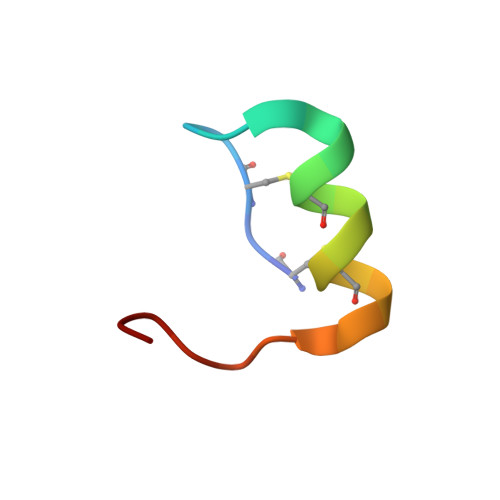Pharmacological and structural characterization of long-sarafotoxins, a new family of endothelin-like peptides: Role of the C-terminus extension.
Mourier, G., Hajj, M., Cordier, F., Zorba, A., Gao, X., Coskun, T., Herbet, A., Marcon, E., Beau, F., Delepierre, M., Ducancel, F., Servent, D.(2012) Biochimie 94: 461-470
- PubMed: 21889567
- DOI: https://doi.org/10.1016/j.biochi.2011.08.014
- Primary Citation of Related Structures:
2LDE, 2LDF - PubMed Abstract:
Long-sarafotoxins (l-SRTXs) have recently been identified in both the venom of Atractaspis microlepidota and that of Atractaspis irregularis. They are characterized by different C-terminus extensions that follow the invariant Trp21, which plays a crucial role in endothelin-receptor binding. We initially determined the toxicity and three-dimensional structures of two chemically synthesized l-SRTXs that have different C-terminus extensions, namely SRTX-m (24 aa, including extension "D-E-P") and SRTX-i3 (25 aa, including extension "V-N-R-N"). Both peptides were shown to be highly toxic in mice and displayed the cysteine-stabilized α-helical motif that characterizes endothelins and short-SRTXs, to which a longer C-terminus with variable flexibility is added. To discern the functional and pharmacological consequences of the supplementary amino acids, different chimerical as well as truncated forms of SRTX were designed and synthesized. Thus, we either removed the extra-C-terminal residues of SRTX-m or i3, or grafted the latter onto the C-terminal extremity of a short-SRTX (s-SRTX) (ie. SRTX-b). Our competitive binding assays where SRTXs competed for iodinated endothelin-1 binding to cloned ET(A) and ET(B) receptor subtypes over-expressed in CHO cells, revealed the essential role of the C-terminus extensions for ET-receptor recognition. Indeed, l-SRTXs displayed an affinity three to four orders of magnitude lower as compared to SRTX-b for the two receptor subtypes. Moreover, grafting the C-terminus extension to SRTX-b induced a drastic decrease in affinity, while its removal (truncated l-SRTXs) yielded an affinity for ET-receptors similar to that of s-SRTXs. Furthermore, we established by intracellular Ca(2+) measurements that l-SRTXs, as well as s-SRTXs, display agonistic activities. We thus confirmed in these functional assays the major difference in potency for these two SRTX families as well as the crucial role of the C-terminus extension in their various pharmacological profiles. Finally, one of the chimeric toxin synthesized in this study appears to be one of the most potent and selective ligand of the ET(B) receptor known to date.
- CEA, iBiTec-S, Service d'Ingénierie Moléculaire des Protéines (SIMOPRO), CEA Saclay, F-91191 Gif sur Yvette, France.
Organizational Affiliation:
















